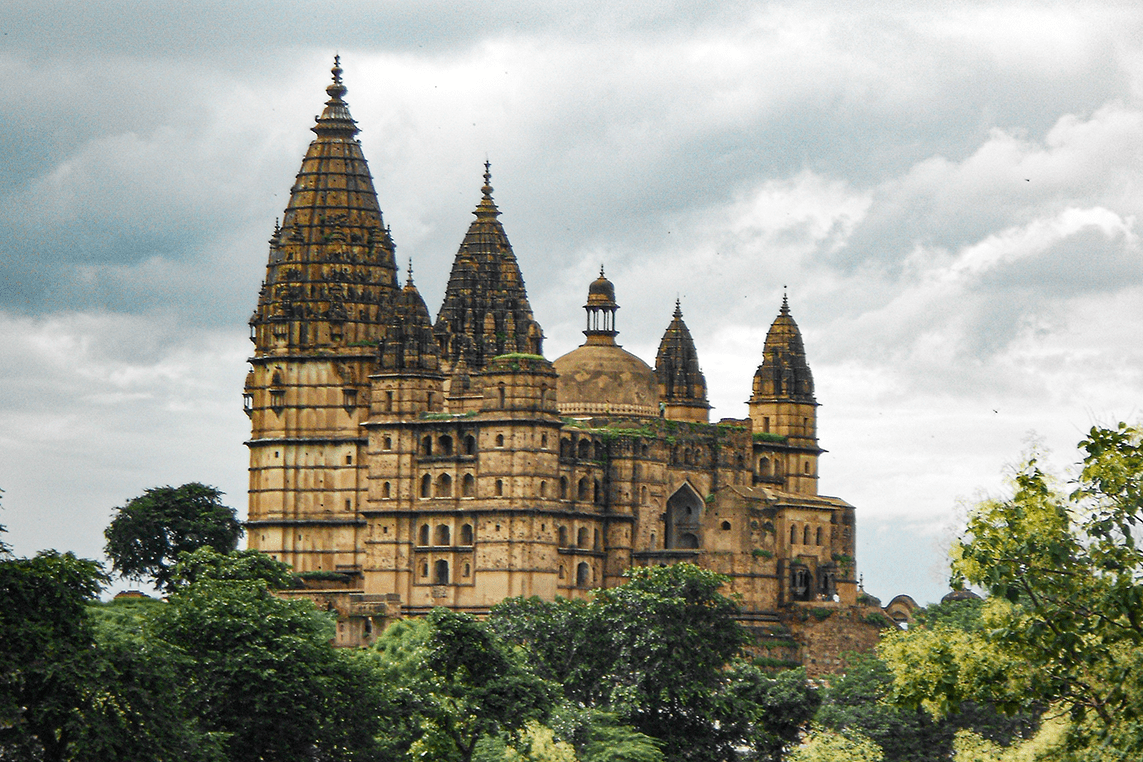I’ve never been able to be a tourist in my hometown. For me, it’s always an exercise of grappling with identity. The town of Orchha in the Bundelkhand region of Madhya Pradesh, near which I was born and that I have continued to visit as a place of pilgrimage, looms large in my psyche. In midst of the otherwise oppressive horizontality of the landscape, the towering verticality of Orchha — with two fortress-like palaces rising from an island on the Betwa river — is an invigorating jolt. Its banks teem with bathing ghats, shrines, gardens, cenotaphs, havelis and more. However, my thoughts, and also the town, are dominated by the 17th-century skyscraper that stands here — the Chaturbhuj Temple.
In the beginning of the 16th century, members of the Bundela clan, who sought to be legitimised as Rajputs (a class of warriors and rulers), established a tiny stronghold in the citadel, since the plateau was apt for building and strategically located. In 1531, Orchha was founded as the capital of Bundelkhand. Construction of the temple was completed by the Bundela chief Vir Singh Deo (also referred to as Bir Singh Deo), under whose reign the kingdom flourished.
Imperial favour from the Mughal emperor Jehangir provided Vir Singh with unprecedented resources to pump into his sparse region. Growing prosperity took the form of architectural consolidation that reshaped the townlet into a cosmopolis of power and piety. As the state temple dedicated to a regal, four-armed form of the Hindu god Vishnu, the Chaturbhuj temple — built from lakhori bricks and topped with stucco — stood as a potent emblem of this sacred urban landscape. Orchha’s architecture drew on vernacular styles, Rajput traditions, architectural precedents of prosperous urban centres nearby — like Gwalior and Chanderi — as well as the Mughals’ use of marble and sandstone, floral carvings, sloping balconies and grand domed structures, especially in the temples that came up here.
Meanwhile, the discovery of neighbouring Mathura and Vrindavan as the Hindu god Krishna’s homeland had made the region an epicentre of the Bhakti movement — a form of worship that advocated intense personal devotion to the divine. Rajput chiefs keenly participated in the movement — Vir Singh more eagerly so, presumably to redeem his reputation as the usurper of his brother’s throne. As popular religion transformed, so did temples — Chaturbhuj was the first one in Orchha, and stands out for its style, imposing size, and unconventionally spacious interior. It shared this in common with contemporaneous Vaishnava temples built by Rajputs in the region, which borrowed from Sultanate and Mughal architecture as well as regional influences and the pre-existing stone-built nagara temple form that was prevalent in northern India.
Like other Bundela temples, Chaturbhuj is crowned by the Bundela shikhara — an octagonal, understated spire resembling a pinecone. Its tallest spire is at 344 feet, making it one of the highest among Hindu temples. To address the need for community worship, the mandapa (hall) and the antarala (vestibule) dispensed with trabeated construction, which uses beams and lintels, in favour of enclosed, large layouts without columns. The Khurasan vaulting system brought by the Mughals was used to support the large halls. The jharokhas on the temple too are borrowed from Mughal architecture.
The paucity of sculptural ornamentation is also surprising to me. The carved decoration at Chaturbhuj was restricted to muqarnas vaults, elephant trunk brackets, chhatris and lotus domes. While nagara temples adhered to a highly ornamental sculptural programme as manifestations of the divinity housed inside, in the new Vaishnava temples, the idol became the focal point of personal devotion and public ritual.
Chaturbhuj reminds me of what Nachiket Chanchani, who teaches Art History at the University of Michigan, argues: that the town can be thought of as “a physical space and a mentality…a grid of beliefs, perspectives, institutions, and practices and etiquette it spawns.” Through patronage that also expanded beyond architecture, Vir Singh’s reign fostered a rare moment in history when it became possible to imagine how a people, albeit an urbanised elite, built a distinctive world around themselves. It gives me clues to my identity and its relation to a place built by those who came to Bundelkhand before me.
Find your way to the Chaturbhuj Temple in Orchha, Madhya Pradesh via Google Maps here.
Our selection of stays across India, best visited for their design and style. Check in
Samarth Singh Chandel (he/him) is a recent History graduate who is currently thinking a lot about the moving image in modern and postmodern contexts. He is on Instagram at @straightouttachandelgarhh.







